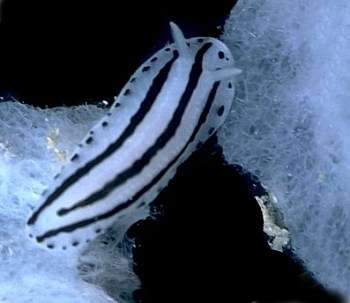
Phyllidiopsis phiphiensis
Brunckhorst, 1993
Order: NUDIBRANCHIA
Suborder: DORIDINA
Family: Phyllidiidae
DISTRIBUTION
Known only from southern Thailand (Andaman Sea, north-eastern Indian Ocean).
PHOTO
4-10 m depth, Phi Phi Island, southern Thailand, 25 Nov. 1989, dorsal view of 10 mm specimen on food sponge, Gellius sp. (Brunckhorst, 1993: Plate 8F).
Notes compiled from Brunckhorst, 1993:
Phyllidiopsis phiphiensis has the following distinctive external characteristics: two low, white ridges separated by three furrows lined with black; white mantle margin with black spots; white rhinophores; and white ventral coloration with black spots on the margin of the hyponotum and on the side of the foot.
There are three other, small, longitudinally striped species of Phyllidiopsis. Two of these, Phyllidiopsis annae and Phyllidiopsis sphingis, are easily separated from the present species because they possess blue pigmentation, grey gills and black (P. annae) or pale yellow (P. sphingis) rhinophores. Phyllidiopsis striata is less easily separated. However, P. striata has three low, white ridges and four black bands (two white ridges and three black bands in P. phiphiensis), lemon yellow rhinophores, and grey and black ventral coloration.
Reference:
• Brunckhorst, D.J. (1993) The systematics and phylogeny of Phyllidiid Nudibranchs (Doridoidea). Records of the Australian Museum, Supplement 16: 1-107.
Rudman, W.B., 1999 (August 1) Phyllidiopsis phiphiensis Brunckhorst, 1993. [In] Sea Slug Forum. Australian Museum, Sydney. Available from http://www.seaslugforum.net/find/phylphip
Related messages
Phyllidiopsis phiphiensis - feeding
March 29, 2003
From: Mary Jane Adams
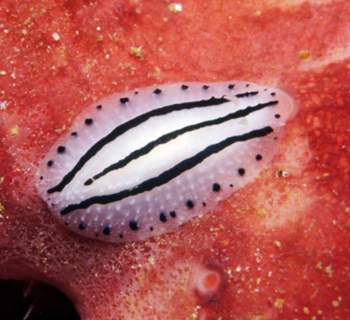
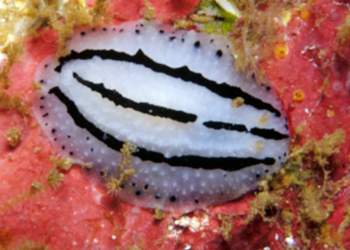
Hi Bill,
I photographed these Phyllidiopsis phiphiensis in the Mergui Archipelago, Andaman Sea, Myanmar. The upper image was shot at Western Rocky on Feb. 25, 2003 at about 10 meters. It appears to be feeding on a red sponge. It was 16 mm long. The slug in the lower image, also on
a red sponge, was shot at Three Islets on Feb. 27, 2003 at about 10 meters. It was 14 mm long. I also photographed the four-striped Phyllidiopsis striata in this area.
Best regards,
Mary Jane
divepng@yahoo.com
Adams, M.J., 2003 (Mar 29) Phyllidiopsis phiphiensis - feeding. [Message in] Sea Slug Forum. Australian Museum, Sydney. Available from http://www.seaslugforum.net/find/9503Dear Mary Jane,
Thanks for another interesting find. Brunckhorst (1993) reports this species feeding on a semitransparent white sponge of the genus Gellius.
Best wishes,
Bill Rudman
Phyllidiopsis phiphiensis from sthn Thailand
January 25, 2003
From: Priscilla Yeo
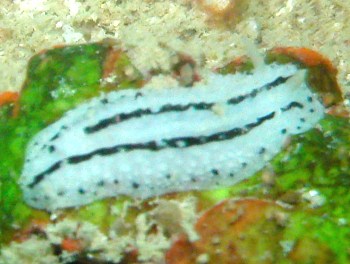
Just found a specimen in south Thailand that I had problem trying to id. I am pretty sure that the image has to be either Phyllidiopsis phiphiensis or P. gemmata.
Laoliang Yei, Trang, south Thailand. depth between 6-8 meters. Picture taken on 2nd January 2003
Priscilla Yeo
prisla@singnet.com.sg
Yeo, P., 2003 (Jan 25) Phyllidiopsis phiphiensis from sthn Thailand. [Message in] Sea Slug Forum. Australian Museum, Sydney. Available from http://www.seaslugforum.net/find/8895Dear Priscilla,
This is Phyllidiopsis phiphiensis. It is the only species with three longitudinal black lines and colourless rhinophores.
Best wishes,
Bill Rudman
Phyllidiopsis phiphiensis from Phi Phi, Thailand
December 24, 2001
From: Walabha Sinbul
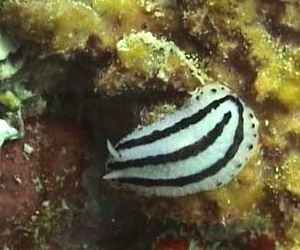
Dear Bill,
It looks to me that my find is Phyllidiopsis striata. My first thought about this animal is P. annae but after I took a good look at its rhinophore I know it's not like what I think. The white rhinophores are a good indication that my humble find is P. striata. Still I need your advice on this.
Locality: Phi Phi, Krabi, Thailand
Depth: 15m
Bottom composition: coral rubbles
Size: 2cm
Regards,
Walabha
walabha@yahoo.com
Sinbul, W., 2001 (Dec 24) Phyllidiopsis phiphiensis from Phi Phi, Thailand. [Message in] Sea Slug Forum. Australian Museum, Sydney. Available from http://www.seaslugforum.net/find/5868Dear Walabha,
Your 'humble' find is Phyllidiopsis phiphiensis, which was named after the very place in which you found it. Both P. strtiata and this species have whitish rhinophores but in Phyllidiopsis phiphiensis there are three black lines on the mantle while in P. striata the central one splits in two to form four lines.
Best wishes,
Bill Rudman
Phyllidiopsis phiphiensis from Thailand
April 6, 2001
From: Erwin Koehler
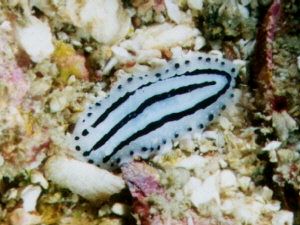
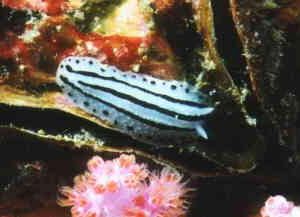
Dear Bill,
Here are some more from Thailand: I am pretty sure both are Phyllidiopsis phiphiensis Brunckhorst, 1993.
They are from the Phi Phi Islands in Thailand!
UPPER PHOTO: divesite "Maya Bay", depth 12m, size 11mm, Jan. 02, 2001,
LOWER PHOTO: divesite "Koh Bida Nok", depth 14m, size 17mm, Jan. 07, 2001
Erwin
Erwin@medslugs.de
Koehler, E., 2001 (Apr 6) Phyllidiopsis phiphiensis from Thailand. [Message in] Sea Slug Forum. Australian Museum, Sydney. Available from http://www.seaslugforum.net/find/4078Dear Eriwn,
They certainly look like P. phiphiensis to me and the Phi Phi Islands is definitely the right place to find them.
Bill Rudman
